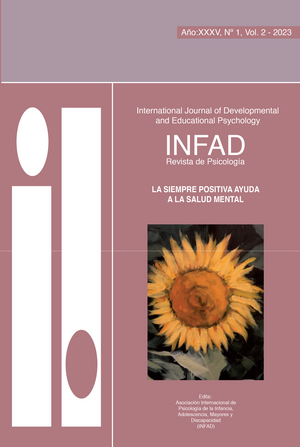Intervención mediante un sistema alternativo-aumentativo de comunicación en discapacidad intelectual y del desarrollo: diseño de caso único
Contenido principal del artículo
Resumen
El desarrollo de las competencias comunicativas en personas con necesidades complejas de comunicación es un tema clave y fundamental para el bienestar de personas con discapacidades intelectuales y del desarrollo. En este trabajo se presentan los resultados de un programa de intervención, diseñado, puesto en práctica y evaluado, de la combinación de un sistema de trabajo individual (TEACCH) con el método por intercambio de imágenes (PECS). Este sistema de enseñanza basado en la comunicación aumentativa y alternativa es único, y enseña, a niños y adultos con autismo y otras deficiencias comunicativas, a iniciarse en la comunicación. El programa se implementó con un caso de una persona con trastorno de espectro autista (tea). Se trataba de un varón de 15 años, escolarizado en un colegio de educación especial, que acudía a un aula especializada para alumnado con tea. Se utilizó una metodología cuantitativa de diseño de caso único, con medidas pre-post. se evaluó el uso del
sistema de comunicación diseñado, así como el bienestar emocional del participante. La intervención se realizó en el contexto familiar de la persona durante tres meses, con tres sesiones de una hora de duración a la semana. el objetivo principal de la intervención fue incrementar la frecuencia de comunicaciones dirigidas a pedir por iniciativa propia. Los resultados del programa diseñado evidenciaron como el uso de PECS incrementó y facilitó el desarrollo de las competencias comunicativas, y mejoró el bienestar emocional de la persona. Como conclusión, se subraya la importancia de implementar estos programas, ya que ayudan a las personas con necesidades complejas de comunicación a ser capaces de transmitir lo que sienten o necesitan en cualquier entorno o situación.
Detalles del artículo
Sección

Esta obra está bajo una licencia internacional Creative Commons Atribución-NoComercial-SinDerivadas 4.0.
Aquellos autores/as que tengan publicaciones con esta revista, aceptan los términos siguientes:
- Los autores/as conservarán sus derechos de autor y garantizarán a la revista el derecho de primera publicación de su obra, el cuál estará simultáneamente sujeto a la Licencia de reconocimiento de Creative Commons que permite a terceros copiar y redistribuir el material en cualquier medio o formato bajo los siguientes términos: —se debe dar crédito de manera adecuada, brindar un enlace a la licencia, e indicar si se han realizado cambios. Puede hacerlo en cualquier forma razonable, pero no de forma tal que sugiera que usted o su uso tienen el apoyo de la licenciante (Atribución); — no se puede hacer uso del material con propósitos comerciales (No Comercial); — si se remezcla, transforma o crea a partir del material, no podrá distribuirse el material modificado (Sin Derivadas).
- Los autores/as podrán adoptar otros acuerdos de licencia no exclusiva de distribución de la versión de la obra publicada (p. ej.: depositarla en un archivo telemático institucional o publicarla en un volumen monográfico) siempre que se indique la publicación inicial en esta revista.
- Se permite y recomienda a los autores/as difundir su obra a través de Internet (p. ej.: en archivos telemáticos institucionales o en su página web) antes y durante el proceso de envío, lo cual puede producir intercambios interesantes y aumentar las citas de la obra publicada. (Véase El efecto del acceso abierto).

Este obra está bajo una licencia de Creative Commons Reconocimiento-NoComercial-SinObraDerivada 4.0 Internacional.
Cómo citar
Referencias
American Psychiatric Association (2014). DSM-5: Manual diagnóstico y estadístico de los trastornos mentales. Madrid: Médica Panamericana.
Bondy, A. y Frost, L. (2002). Picture Exchange Communication System PECS. Estados Unidos: Pyramid Educational Products.
Carvajal-García, M. H., y Triviño-Sabando, J. R. (2021). Sistema de comunicación por intercambio de imágenes (PECS): Alternativa en la comunicación de niños con autismo. Polo del Conocimiento, 6(5), 87-99. https://doi.org/10.23857/pc.v6i5.2633
Fortea-Sevilla M. S., Escandell-Bermúdez M. O., Castro-Sánchez J. J. y Martos-Pérez J. (2015). Desarrollo temprano del lenguaje en niños pequeños con trastorno del espectro autista mediante el uso de sistemas alternativos utilizando sistemas alternativos. Revista de Neurología, 60(1), 31-35. https://doi.org/10.33588/rn.60S01.2014566
Gómez, L. E., Alcedo, M. A., Verdugo, M. A., Arias, B., Arias, V., Monsalve, A., Fontanil, Y. y Morán, L. (2016). KidsLife: evaluación de la calidad de vida de niños de niños y adolescentes con discapacidad intelectual. Salamanca: INICO.
Jaramillo-Arias, P., Sampedro-Tobón, M. E., y Sánchez-Acosta, D. (2022). Perspectiva histórica del trastorno del espectro del autismo. Acta Neurológica Colombiana, 38(2), 91-97. https://doi.org/10.22379/24224022405
Lledó, G. L., Lorenzo-Lledó, A., Carreres, A. L., y Pérez-Vázquez, E. (2023). Creación de un entorno de realidad virtual inmersiva para la comunicación e interacción social: estudio piloto en alumnado con trastorno del espectro autista. Revista de Educación a Distancia (RED), 23(73). https://doi.org/10.6018/red.539141
Marco, C. S. A. (2020). El método TEACCH (abreviación en inglés de Tratamiento y Educación de niños con Autismo y Problemas de Comunicación relacional. http://www.quadernsdigitals.net/datos_web/hemeroteca/r_1/nr_796/a_10730/10730.html
Marín Martínez, A. (2019). Sistemas Alternativos y Aumentativos de Comunicación. PublicacionesDidacticas.com, 104, 235-240. https://core.ac.uk/download/pdf/235850452.pdf
Mesibov, G. y Howley, M. (2010). El acceso al currículo por alumnos con Trastornos del Espectro del Autismo: Uso del programa TEACCH para favorecer la inclusión. Ávila: Autismo Ávila. https://catalogo.autismoavila.org/el-acceso-al-curr%C3%ADculo-para-alumnos-con-tea
Mira, R. y Grau, C. (2017). Los sistemas alternativos y aumentativos de comunicación (SAAC) como instrumento para disminuir conductas desafiantes en el alumnado con TEA: estudio de un caso. Revista Española de Discapacidad, 5(1), 113-132. https://doi.org/10.5569/23405104.05.01.07.
Sanz-Cervera, P., Fernández-Andrés, M. I., Pastor-Cerezuela, G., y Tárraga-Mínguez, R. (2018). Efectividad de las intervenciones basadas en metodología TEACCH en el trastorno del espectro autista: un estudio de revisión. Papeles del Psicólogo, 39(1), 40-50. https://doi.org/10.23923/pap.psicol2018.2851
Sevilla, J., Vera, L., Herrera, G., y Fernández, M. (2018). FORHHSS-TEA, Support to the Individual Work System for People with Autism Spectrum Disorder Using Virtual and Augmented Reality. In CEIG (pp. 55-64).
Tamarit, J. (1989). Uso y abuso de los sistemas alternativos de comunicación. Comunicación, Lenguaje y Educación, 1, 81-94. file:///C:/Users/Usuario/Downloads/DialnetUsoYAbusoDeLosSistemasDeComunicacion-126151.pdf
Zebiri, S. (2020). Estimulación de la comunicación en niños con TEA entre 3 y 12 años: efectividad del sistema PECS. Trabajo de revisión bibliográfica, Universidad Central de Catalunya. Repositorio institucional UMANRESA. http://repositori.umanresa.cat/1/530

